Link to Photosynthesis Student Learning Guide (coming at some point. Email me if you need it)
1. Introduction
 In the last tutorial we talked about how photosynthesis occurs in two stages: the light reactions (Roman numeral “I,” at left) and the Calvin cycle (“II”)
In the last tutorial we talked about how photosynthesis occurs in two stages: the light reactions (Roman numeral “I,” at left) and the Calvin cycle (“II”)
During the light reactions, a chloroplast carries out two energy transformations:
- Taking light energy (indicated by “1” at left”) and transforming it into an electrical current. That current isn’t shown in this diagram, and we’ll address it below.
- Taking that electrical current and using it to make ATP (4) and NADPH (5).
In the Calvin Cycle, a third energy transformation occurs: the ATP and NADPH from the light reactions are used to convert carbon dioxide (at 6) into sugars such as glucose (at 7).
In this tutorial, we’re going to learn how the energy transformations involved in the light reactions happen. To do that, we’re going to go inside a chloroplast (“m,” below) into a thylakoid sac (“n”), and explore what happens along the membrane of a single thylakoid (indicated by “o”). As complex as the diagram below might seem, by the time we’re done you’ll be able to identify every part and explain the overall process.
Let’s go.

2. First, a bit of physics and chemistry: electrons, protons, oxidation and reduction
Before we get into the details, we need to review (or learn) some chemistry.
To understand what happens during the light reactions, it’s useful to understand the structure of atoms. If you need to review that, you can do so in this series of tutorials.
In addition. here are a few more key ideas.
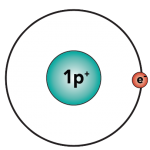
- Photosynthesis involves creation of electrical currents, powered by light energy. For our purposes, just think of an electrical current as a flow of electrons. Electrons are the negatively charged particles that orbit around the nucleus of an atom. You can imagine these electrons flowing through a wire, just like water flows through a pipe. Flowing water has energy. So do flowing electrons. In what’s below, we’ll see how chloroplasts use the energy of flowing electrons to make ATP and NADPH.
- Photosynthesis also involves the movement of protons. A proton is a positively charged particle, mostly found in the nucleus of an atom. If you take a hydrogen atom, with one proton and one electron, and remove the electron, you have a proton.
Charged particles are also called “ions.” For this reason, protons are often called “hydrogen ions,” and symbolized as H+. If you can remember that an H+ is a proton, you’ll be fine.
The next idea relates to that fact that chemically speaking, photosynthesis involves a series of oxidation-reduction reactions.
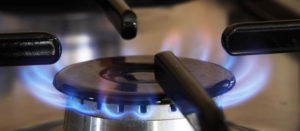
Oxidation means loss of electrons. Oxidation is always paired with a complementary process called reduction, which means gain of electrons. Often, oxidation and reduction involve the loss and gain of hydrogen, too.
Every time you drive a car, light a match, or operate a gas stove, you’re involved with an oxidation-reduction reaction. These are oxidation-reduction reactions that release energy in the form of heat and light. Photosynthesis is an oxidation-reduction reaction that converts light energy it into chemical energy.
Here’s the equation for what happens when methane, CH4 (commonly called “natural gas”) is burned:
CH4 + 2O2 –> CO2 + 2H2O + energy (in the form of heat and light)
In the reaction above, methane (CH4), an energy-rich fuel, is oxidized. It’s losing electrons and hydrogen. The oxidized exhaust product is carbon dioxide (CO2), which unlike methane has no hydrogen. At the same time that methane is being oxidized, oxygen (O2) is being reduced, gaining electrons and hydrogens, becoming water (H2O).
Compare the oxidation of methane with what happens in photosynthesis.
6CO2 + 6H2O + light energy –> C6H12O6 + 6O2.
During photosynthesis, carbon dioxide is reduced. It gains electrons and hydrogens. At the end of the process, we have simple sugars like glucose, C6H12O6. Glucose is highly reduced compound. Like methane, glucose has lots of chemical energy. Like methane, glucose is a fuel: it’s the fuel that powers cellular respiration, enabling your cells to make ATP so that they can carry out the work they need to do to keep you alive.
During photosynthesis, the reduction of carbon dioxide is paired with the oxidation of water, which loses electrons and hydrogens. Unlike the oxidation of methane, which releases energy, the oxidation of water requires energy. That energy is supplied by light.
Knowing what we know now about oxidation and reduction, let’s look again at the three energy transformations involved in photosynthesis.
- In the first energy transformation, light energy is converted into an electrical current. Where do the electrons come from? They come from water, which gets oxidized during photosynthesis. As water get oxidized, it loses electrons and hydrogens. These lost electrons are the source of the electrical current in photosynthesis. In addition, the oxidation of water results in the release of oxygen gas, which is a waste product of the light reactions.
- In the second transformation, electricity is converted into the short-term chemical energy of ATP and NADPH. We’ll explain more about both of these processes below. The important point for now is that the conversion of NADP+ to NADPH is a reduction. Another way to say that is that the oxidation of water supplies the electrons and hydrogens for the reduction of NADP+ into NADPH.

- The third energy transformation in photosynthesis happens during the Calvin cycle. In the Calvin cycle, NADPH provides the electrons and hydrogens for reducing carbon dioxide molecules into simple sugars. NADPH does this by being oxidized to NADP+. The reduction of CO2 into sugar requires energy, and that energy is supplied by ATP (the other product of the light reactions).
Before going further, let’s consolidate and review.
[qwiz qrecord_id=”sciencemusicvideosMeister1961-Photosynthesis, Oxidation and Reduction (HS)”]
[h]Photosynthesis, Oxidation and Reduction
[q]
[c]IGxpZ2h0IHJlYWN0aW9ucw==[Qq]
[c]IENhbHZpbiBjeWNsZQ==[Qq]
[c]IEFUUA==[Qq]
[c]IE5BRFBI[Qq]
[c]IHdhdGVy[Qq]
[c]IG94eWdlbg==[Qq]
[q labels = “top”]
[l]oxidation
[fx] No, that’s not correct. Please try again.
[f*] Good!
[l]reduction
[fx] No. Please try again.
[f*] Excellent!
[q]Photosynthesis involves two stages, and [hangman] energy transformations. In the first energy transformation, [hangman] energy is converted into an electrical current. The electrons flowing in this electrical current are supplied by [hangman], which is [hangman].
[c]dGhyZWU=[Qq]
[c]bGlnaHQ=[Qq]
[c]d2F0ZXI=[Qq]
[c]b3hpZGl6ZWQ=[Qq]
[q]Photosynthesis involves two stages, and three energy transformations. In the second energy transformation, two things happen:
- electrons [hangman] NADP+ into [hangman].
- ADP is converted into [hangman]
[c]cmVkdWNl[Qq]
[c]TkFEUEg=[Qq]
[c]QVRQ[Qq]
[q]Gain of electrons is known as [hangman]. Loss of electrons is [hangman]
[c]cmVkdWN0aW9u[Qq]
[c]b3hpZGF0aW9u[Qq]
[q]During photosynthesis, [hangman] (at 6) is reduced, forming simple sugars such as [hangman] (at 7). At the same time [hangman] (at 2) is oxidized, resulting in the release of [hangman] (at 3)
[c]Y2FyYm9uIGRpb3hpZGU=[Qq]
[c]Z2x1Y29zZQ==[Qq]
[c]d2F0ZXI=[Qq]
[c]b3h5Z2Vu[Qq]
[/qwiz]
3. How the light reactions generate electron flow to reduce NADP+ to NADPH
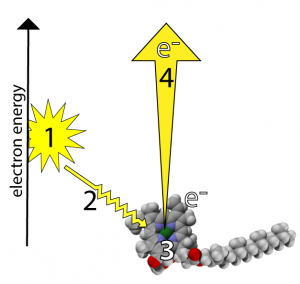 Chloroplasts are able to carry out photosynthesis because of a green pigment molecule called chlorophyll, which is found in the thylakoid membrane. Pigments are substances that reflect certain frequencies of light, and absorb others. Chlorophyll reflects green light, and absorbs red and blue light (which is why plants are green).
Chloroplasts are able to carry out photosynthesis because of a green pigment molecule called chlorophyll, which is found in the thylakoid membrane. Pigments are substances that reflect certain frequencies of light, and absorb others. Chlorophyll reflects green light, and absorbs red and blue light (which is why plants are green).
Here’s how chlorophyll (3 in the diagram at right) works. When a light source (indicated by 1) emits light energy (2), electrons in chlorophyll can be excited, which increases their energy level. Note that in all of the diagrams in this tutorial, electrons are represented by “e–.” Number 4 at right shows one such excited electron.
Excited electrons have energy that can be used to perform work. Because we’re talking about the light reactions of photosynthesis, the work is to create NADPH and ATP. Let’s start with NADPH.

In a chloroplast, chlorophyll molecules are organized into photosystems. Photosystems are complexes of connected proteins which are embedded in the membranes of the thylakoid sacs. In the diagram above, two photosystems are shown: one is at letter “l,” and the second is at letter “e.” If you follow the arrows in the diagram above, you’ll notice that electrons first flow through Photosystem 2, and then proceed to Photosystem 1. This is because the photosystems were named based on the order of their discovery. Like all the biology students who have learned this material before you, you just have to memorize the fact that as electrons flow along a thylakoid membrane, they flow through Photosystem 2 first, then through Photosystem 1.
In the diagram, you can see light energy (at “a”) striking Photosystem 2 (at “l”). This excites the chlorophyll molecules in Photosystem 2. The excitation of chlorophyll, combined with enzyme-like features of Photosystem 2, allows Photosystem 2 to oxidize water molecules. As their electrons are ripped away, those water molecules fall apart. The result is oxygen gas (O2) and protons (represented by H+). This oxidation/falling apart of water is shown at “k.”
These excited electrons are delivered to an electron transport chain, indicated by letter “b.” You can think of the electron transport chain as a biological wire. In our experience with electricity, we use wires to bring electrical energy to devices so that they’ll do work. The same thing is happening here, except for that the wires in the electron transport chain are made of protein, and the “devices” are very small. One such device is shown at “c.” It’s a proton pump, and it pumps protons from the the stroma (the area outside the thylakoid sacs) into the tiny enclosed space inside each thylakoid: the thylakoid space. In the diagram above, that means pumping protons from region “1” to region “2.” We’ll come back to these pumped protons in a moment, when we learn about the creation of ATP.
Letter “d” shows another wave of light energy being absorbed by a photosystem. This time it’s Photosystem 1. Photosystem 1 boosts the energy level of the incoming electron from Photosystem 2, and sends it to another electron transport chain. This electron transport chain sends high energy electrons to an enzyme called NADP+ reductase. The name tells you what it does: it reduces NADP+ to NADPH.
Pretty good! We’ve accounted for the creation of one of the two products of the light reactions: NADPH. We’ve also explained how the input for the light reactions (water) gets consumed as it’s oxidized, which transforms it into oxygen gas, electrons, and protons.
The last thing to account for is the creation of ATP. Before we go there, let’s consolidate what we learned about above: chlorophyl, photosystems, and the production of NADPH.
4. Checking Understanding: making NADPH
[qwiz style=” width: 750px !important; min-height: 400px !important;” qrecord_id=”sciencemusicvideosMeister1961-Photosynthesis, Making NADPH (HS)”] [q] In the diagram below, an excited electron is represented by
[textentry single_char=”true”]
[c]ID Q=
[f]IEdvb2Qgd29yay4gJiM4MjIwOzQmIzgyMjE7IGlzIGFuIGVsZWN0cm9uIHRoYXQmIzgyMTc7cyBiZWVuICYjODIyMDtib29zdGVkJiM4MjIxOyBieSBsaWdodCBlbmVyZ3ku[Qq]
[c]IEVudGVyIHdvcmQ=[Qq]
[c]ICo=[Qq]
[f]IE5vLiBIZXJlJiM4MjE3O3MgYSBoaW50LiBlLSByZXByZXNlbnRzIGFuIGVsZWN0cm9uLiBUaGUgWSBheGlzIGlzIGVsZWN0cm9uIGVuZXJneS5XaGVyZSBpcyB0aGVyZSBhbiBlbGVjdHJvbiB3aXRoIGEgaGlnaCBlbmVyZ3kgbGV2ZWw/[Qq]
[q] In the diagram below, chlorophyll is represented by number
[textentry single_char=”true”]
[c]ID M=
[f]IE5pY2Ugam9iLiAmIzgyMjA7MyYjODIyMTsgaXMgY2hsb3JvcGh5bGwu[Qq]
[c]IEVudGVyIHdvcmQ=[Qq]
[c]ICo=[Qq]
[f]IE5vLiBIZXJlJiM4MjE3O3MgYSBoaW50OiB0aGUgbW9sZWN1bGUgaXMgYnVpbHQgb2YgYXRvbXMsIHdoaWNoIGFyZSByZXByZXNlbnRlZCBieSBzcGhlcmVzIG9mIGRpZmZlcmVudCBjb2xvcnMu[Qq]
[q] In the diagram below, a thylakoid sac is represented by
[textentry single_char=”true”]
[c]IG 4=
[f]IFdheSB0byBnby4gTGV0dGVyICYjODIxNjtuJiM4MjIxOyByZXByZXNlbnRzIGEgdGh5bGFrb2lkIHNhYy4=[Qq]
[c]IEVudGVyIHdvcmQ=[Qq]
[c]ICo=[Qq]
[f]IE5vLiBIZXJlJiM4MjE3O3MgYSBoaW50LiBJbiB0aGlzIGRpYWdyYW0sIHRocmVlIHRoeWxha29pZCBzYWNzIGFyZSBzdGFja2VkIHRvZ2V0aGVyLg==[Qq]
[q] In the diagram below, the thylakoid membrane is represented by
[textentry single_char=”true”]
[c]IG 8=
[f]IEdvb2Qgd29yay4gTGV0dGVywqAgJiM4MjE2O28mIzgyMjE7IHJlcHJlc2VudHMgdGhlIHRoeWxha29pZCBtZW1icmFuZS4=[Qq]
[c]IEVudGVyIHdvcmQ=[Qq]
[c]ICo=[Qq]
[f]IE5vLiBIZXJlJiM4MjE3O3MgYSBoaW50LiBJbiB0aGlzIGRpYWdyYW0sIHRocmVlIHRoeWxha29pZCBzYWNzIGFyZSBzdGFja2VkIHRvZ2V0aGVyLg==[Qq]
[q] In the diagram below, the stroma is represented by
[textentry single_char=”true”]
[c]ID E=
[f]IENvcnJlY3QuIE51bWJlciAxIHJlcHJlc2VudHMgdGhlIHN0cm9tYS4=[Qq]
[c]IEVudGVyIHdvcmQ=[Qq]
[c]ICo=[Qq]
[f]IE5vLiBIZXJlJiM4MjE3O3MgYSBoaW50LiBUaGUgc3Ryb21hIGlzIHRoZSBmbHVpZCBvdXRzaWRlIG9mIHRoZSB0aHlsYWtvaWQgc2FjLg==[Qq]
[q] In the diagram below, the electron transport chain of Photosystem 2 is represented by
[textentry single_char=”true”]
[c]IG I=
[f]IFllcyEgTGV0dGVyICYjODIyMDtiJiM4MjIxOyByZXByZXNlbnRzIHRoZSBlbGVjdHJvbiB0cmFuc3BvcnQgY2hhaW4gb2YgcGhvdG9zeXN0ZW0gMi4=[Qq]
[c]IEVudGVyIHdvcmQ=[Qq]
[c]ICo=[Qq]
[f]IE5vLiBIZXJlJiM4MjE3O3MgYSBoaW50LiBGaW5kIHBob3Rvc3lzdGVtIDIuIFRoZW4gZmluZCB3aGVyZSBlbGVjdHJvbnMgYXJlIGZsb3dpbmcu[Qq]
[q] In the diagram below, the splitting apart of water is represented by letter
[textentry single_char=”true”]
[c]IG s=
[f]IEdvb2Qgd29yayEgTGV0dGVyICYjODIyMDtrJiM4MjIxOyByZXByZXNlbnRzIHRoZSBzcGxpdHRpbmcgYXBhcnQgb2Ygd2F0ZXIu[Qq]
[c]IEVudGVyIHdvcmQ=[Qq]
[c]ICo=[Qq]
[f]IE5vLiBIZXJlJiM4MjE3O3MgYSBoaW50LiBGaW5kIHdoZXJlIEg=Mg==TyBpcyBicm9rZW4gZG93biBpbnRvIE8=Mg==IGFuZCB0d28gcHJvdG9ucyAoSA==[Qq]+)
[q] In the diagram below, the reduction of NADP+ is shown at
[textentry single_char=”true”]
[c]IG c=
[f]IEdvb2Qgd29yayEgTGV0dGVyICYjODIyMDtnJiM4MjIxOyByZXByZXNlbnRzIHRoZSByZWR1Y3Rpb24gb2YgTkFEUA==Kw==IHRvIE5BRFBILg==[Qq]
[c]IEVudGVyIHdvcmQ=[Qq]
[c]ICo=[Qq]
[f]IE5vLiBIZXJlJiM4MjE3O3MgYSBoaW50LiBGaW5kIE5BRFA=Kw==[Qq]
[q]In the diagram below, “o” represents a [hangman] membrane.
[c]dGh5bGFrb2lk[Qq]
[q]In the diagram below, “b” represents the [hangman] transport [hangman] of photosystem 2.
[c]ZWxlY3Ryb24=[Qq]
[c]Y2hhaW4=
[q]Because it involves the loss of electrons, “k” can be described as the [hangman] of water.
[c]b3hpZGF0aW9u[Qq]
[q]Because it involves the gain of electrons, “g” can be described as the [hangman] of NADP+ to NADPH.
[c]cmVkdWN0aW9u[Qq]
[/qwiz]
5. How the light reactions create proton gradients to generate ATP
Let’s now turn to how ATP is made.

In the previous sections, we’ve discussed how a chloroplast is able to take light energy (“a” and “d” above) and convert it into an electrical current flowing down an electron transport chain (“b” and “f” above). The electron energy from Photosystem 1’s electron transport chain at “f” is used to reduce NADP+ into NADPH (shown at “g”).
Photosystem 2’s electron transport chain (at “b”) powers a proton pump (at “c”). This pump moves protons (H+) from the stroma (region 1) into the thylakoid space (region 2). This process requires energy because it’s moving protons from lower concentration in the stroma to higher concentration in the thylakoid space. In other words, it’s a type of active transport.
To clarify all of these relationships, study the diagram below. This diagram is showing a single thylakoid sac, bounded by a thylakoid membrane (indicated by “o”).
- Number “1” indicates the stroma (the fluid outside the thylakoid).
- Number 2 indicates the fluid inside thylakoid space.
- Letter “c” shows a proton pump, which is pumping electrons from the stroma to the thylakoid space.
- Letter “k” is showing the splitting of water in Photosystem 2. Note that when a water molecule splits apart, the result is protons and an oxygen gas. The actual ratio is 4H+ + one O2 for every two H20 molecules that get oxidized.
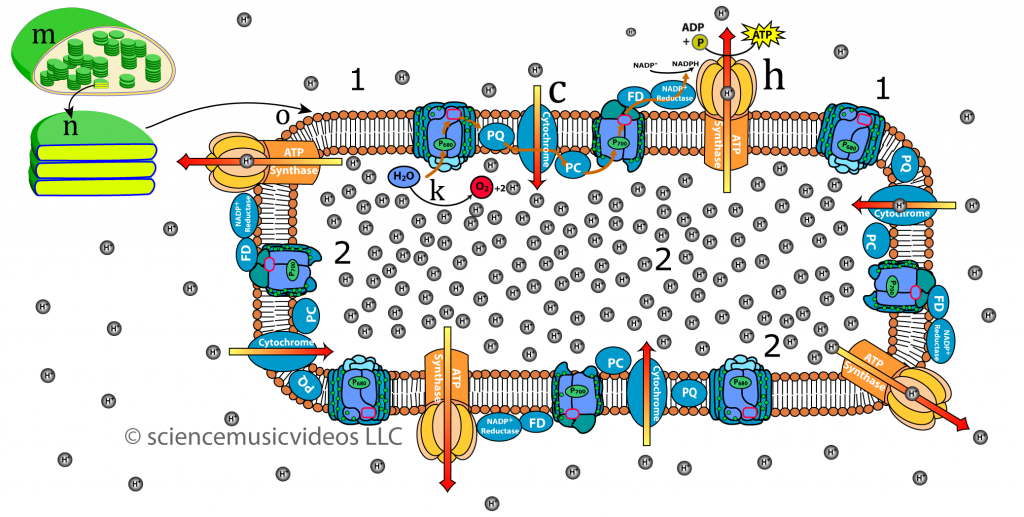
The combined effect of proton pumping at “c” and the oxidation of water at “j” makes the fluid inside the thylakoid space different from the fluid in the stroma. Protons are at a much higher concentration inside the thylakoid space than they are in the stroma. There’s also a difference in electrical charge across the thylakoid membrane. Because protons are positively charged, the inside of the thylakoid has many more positive charges than the outside.
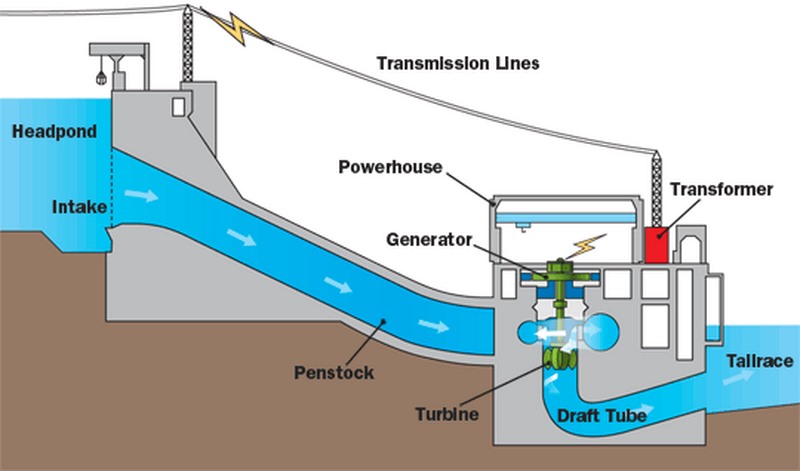 Note that if what follows seems familiar, it’s because the way that ATP is made in the light reactions is extremely similar to how it occurs during cellular respiration.
Note that if what follows seems familiar, it’s because the way that ATP is made in the light reactions is extremely similar to how it occurs during cellular respiration.
The difference in charge and proton concentration between the thylakoid space and the stroma is like water trapped behind a dam. It’s a source of potential energy. So let’s think for a minute about how a hydroelectric power station works. In the diagram at left, the water behind the dam is stored in a headpond. When the intake is opened, that water flows through a channel (the penstock) which brings it to a turbine. The force of the water flowing through the turbine forces the turbine to rotate, which powers an electrical generator.
In a hydroelectric power station, the energy stored in water trapped behind a dam is used to make electricity. In a thylakoid sac, the stored energy of protons trapped inside the thylakoid space is used to create ATP. While protons don’t have feelings or motives, it’s useful to imagine that the protons “want” to get out of the thylakoid space. Two forces are motivating them. First, the tendency of all particles is to diffuse from higher concentration to lower concentration. These protons are in much higher concentration inside the thylakoid sac than outside, so they naturally “want” to get out. Second, like charges repel, and opposite charges attract. All of those positively charged protons are “trying” to get away from one another, and “trying” to get to the more negatively charged stroma.
 As with any biological membrane, the phospholipid portion of the thylakoid membrane is impermeable to charged particles, such as protons. However, there is one channel that the protons can pass through. It’s the ATP synthase channel, shown at letter “i” to the right.
As with any biological membrane, the phospholipid portion of the thylakoid membrane is impermeable to charged particles, such as protons. However, there is one channel that the protons can pass through. It’s the ATP synthase channel, shown at letter “i” to the right.
The ATP synthase channel is also an enzyme. The active site of this enzyme has binding sites for ADP and phosphate. As protons diffuse through the channel, their energy of motion (also called kinetic energy) is used to rotate the binding sites on ATP synthase. That rotation forces an ADP to combine with a phosphate group, forming ATP.
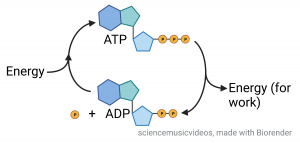
Keep in mind that the movement of protons through ATP synthase is what’s called facilitated diffusion. The cell doesn’t need to expend any additional energy to move protons from the thylakoid space to the stroma. It just needs to let them diffuse. As the protons flow through ATP synthase, their energy of motion (or kinetic energy) provides the power to convert ADP and phosphate into ATP.
6. ATP Synthesis in the Light Reactions: Checking Understanding
[qwiz style=”width: 700px !important; min-height: 400px !important;” qrecord_id=”sciencemusicvideosMeister1961-Photosynthesis, Making ATP (HS)”]
[h]The Light Reactions and ATP
[i]
[q]In the diagram below, what letter represents a proton pump?
[textentry single_char=”true”]
[c]IG M=[Qq]
[f]IEV4Y2VsbGVudC4gTGV0dGVyICYjODIyMDtjJiM4MjIxOyByZXByZXNlbnRzIGEgcHJvdG9uIHB1bXAu[Qq]
[c]IEVudGVyIHdvcmQ=[Qq]
[c]ICo=[Qq]
[f]IE5vLiBIZXJlJiM4MjE3O3MgYSBoaW50LiBMb29rIGZvciBzb21ldGhpbmcgdGhhdCYjODIxNztzIG1vdmluZyBwcm90b25zIChIKw==KSBmcm9tIHRoZSBzdHJvbWEgKDEpIHRvIHRoZSB0aHlsYWtvaWQgc3BhY2UgKDIpLg==[Qq]
[q] Besides “c,” which letter represents a process that’s increasing the concentration of protons in the thylakoid space?
[textentry single_char=”true”]
[c]aw ==
[f]IEdvb2Qgd29yay4gVGhlIHNwbGl0dGluZyBvZiB3YXRlciBnZW5lcmF0ZXMgZWxlY3Ryb25zICh3aGljaCBmbG93IGluIHRoZSBlbGVjdHJvbiB0cmFuc3BvcnQgY2hhaW4pLiBJdCBhbHNvIHJlc3VsdHMgaW4gb3h5Z2VuIChhIHdhc3RlIHByb2R1Y3QpIGFuZCBwcm90b25zIChIKw==KSwgd2hpY2ggYWNjdW11bGF0ZSBpbiB0aGUgdGh5bGFrb2lkIHNwYWNlLg==[Qq]
[c]IEVudGVyIHdvcmQ=[Qq]
[c]ICo=[Qq]
[f]IE5vLiBMb29rIGZvciBhIHByb2Nlc3MgYmVzaWRlcyBwcm90b24gcHVtcGluZyB0aGF0JiM4MjE3O3MgY2F1c2luZyBwcm90b25zIHRvIGFjY3VtdWxhdGUgaW4gdGhlIHRoeWxha29pZCBzcGFjZS4=[Qq]
[q] In the diagram below, which letter or number represents the thylakoid space?
[textentry single_char=”true”]
[c]Mg ==
[f]IE5pY2UhIE51bWJlciAmIzgyMjA7MiYjODIyMTsgcmVwcmVzZW50c8KgdGhlIHRoeWxha29pZCBzcGFjZS4=[Qq]
[c]IEVudGVyIHdvcmQ=[Qq]
[c]ICo=[Qq]
[f]IE5vLiBIZXJlJiM4MjE3O3MgYSBoaW50OiB0aGUgdGh5bGFrb2lkIHNwYWNlIGlzIGluc2lkZSB0aGUgdGh5bGFrb2lkLCBzdXJyb3VuZGVkIGJ5IHRoZSB0aHlsYWtvaWQgbWVtYnJhbmUu[Qq]
[q] In the diagram below, which letter or number represents ATP synthase?
[textentry single_char=”true”]
[c]aA ==
[f]IE5pY2UhIExldHRlciAmIzgyMjA7aCYjODIyMTsgcmVwcmVzZW50cyBBVFAgc3ludGhhc2Uu[Qq]
[c]IEVudGVyIHdvcmQ=[Qq]
[c]ICo=[Qq]
[f]IE5vLiBIZXJlJiM4MjE3O3MgYSBoaW50OkFUUCBzeW50aGFzZSBpcyBhbiBlbnp5bWUgYW5kIGEgY2hhbm5lbCB0aGF0IG1ha2VzIEFUUCBmcm9tIEFEUCBhbmQgYSBwaG9zcGhhdGUgZ3JvdXAu[Qq]
[q]At letter “c” in the diagram below, protons are being [hangman] from the [hangman] to the thylakoid space. Because protons are being moved up a concentration gradient, this process can described as [hangman].
[c]cHVtcGVk[Qq]
[c]c3Ryb21h[Qq]
[c]YWN0aXZlIHRyYW5zcG9ydA==[Qq]
[q]At letter “h” in the diagram below, one can see how ATP is generated by the light reactions. As [hangman] diffuse from the [hangman] space to the [hangman], their kinetic energy is used to make ATP from ADP and P.
[c]cHJvdG9ucw==[Qq]
[c]dGh5bGFrb2lk[Qq]
[c]c3Ryb21h[Qq]
[q]Letter “i” in the diagram below shows how the diffusion of [hangman] through the ATP [hangman] channel is the immediate source of energy for the synthesis of ATP.
[c]cHJvdG9ucw==[Qq]
[c]c3ludGhhc2U=[Qq]
[/qwiz]
7. The Z scheme
In the previous sections, we’ve looked at how a flow of electrons, powered by light, is used to synthesize ATP and NADPH. The Z scheme is a graphical way of depicting how chloroplasts (and other photosynthesizing organisms like cyanobacteria ) carry out this work. The work involves boosting the energy level of electrons, then harvesting energy as the electrons flow along an electron transport chain. Understanding the Z scheme will deepen your understanding of the material we just covered (and because of the learning you just did, understanding the Z scheme should be easy).
Why is it called the Z scheme? I have always thought that “N” scheme would have made more sense (because the rise in electron energy, followed by the downward sloping loss of energy, followed by another rise looks to me like an “N”). But it’s been called the “Z scheme” since the 1950s. Let’s see how it works.
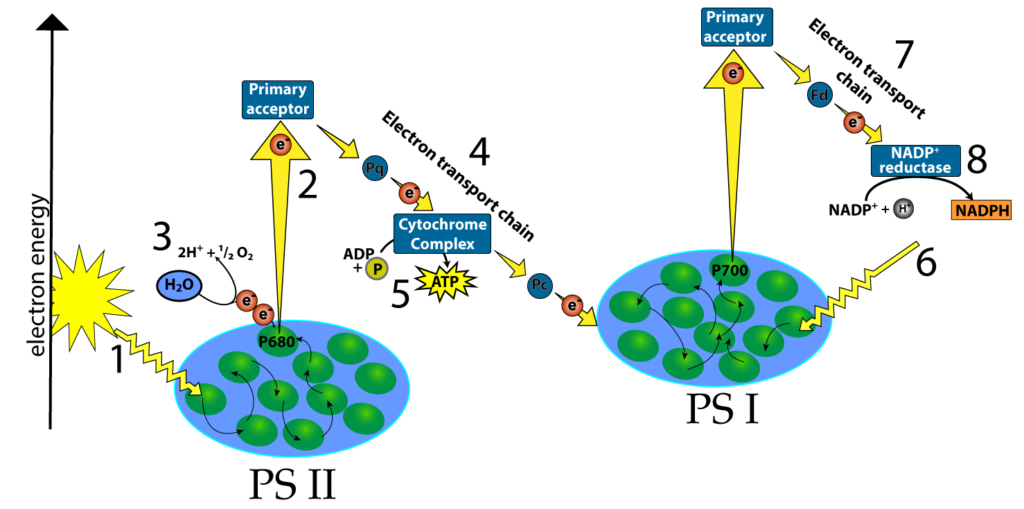
- Light energy is absorbed by chlorophylls in Photosystem II.
- An electron in one chlorophyll molecule gets an energy boost. This chlorophyll is labeled “P680” for the wavelength of light that stimulates it the most. This boost enables that electron to jump (energetically speaking) toward what’s called a “primary electron acceptor.” This is a part of Photosystem II that takes energized electrons and passes them off to an electron transport chain.
- When PS II’s primary electron acceptor accepts P680’s electron, that chlorophyll becomes oxidized. In response, PS II rips electrons away from a water molecule. The water dissociates into protons and oxygen.
- PS II’s primary electron acceptor passes its energized electrons to an electron transport chain.
- As the electrons flow down the electron transport chain, they power cellular work: in this case the work of creating ATP from ADP and phosphate. (Note: we know how this happens: proton pumping, proton accumulation, and diffusion through ATP synthase. But because the Z scheme is about following the electrons, none of that is in the diagram).
- The electron from PS II arrives at PS I in a low energy condition. But, as it’s been traveling, photons have been shining on PS1, and energizing its electrons. The energy bounces to a chlorophyll labeled as “P700.” P700’s electrons are boosted in energy and then snatched away by PS I’s primary electron acceptor. These lost electrons are replaced by the electrons arriving from PS II (which can ultimately be traced to water).
- PS I’s primary electron acceptor passes its energized electrons to PS 1’s electron transport chain. This electron transport chain, however, doesn’t pump protons. Instead, it channels PS I’s high energy electrons to the enzyme NADP+ reductase.
- NADP+ reductase uses the incoming electron’s energy to convert oxidized, low-energy NADP+ into high energy, reduced NADPH.
8. The Light Reactions and the Z-Scheme: Checking Understanding
The quiz below will test you on the Z-scheme, other material about the light reactions, and more general material about photosynthesis. Note that this quiz includes some big diagrams. You might have to adjust the display on your screen (Ctrl – on Windows, Command – on Mac) for them to fit on your screen).
[qwiz style=”width: 800px;” random = “false” qrecord_id=”sciencemusicvideosMeister1961-Photosynthesis, Light Reactions and Z scheme (HS)”]
[h]The Light reactions and the Z Scheme
[i]
[q labels = “top”]
[l]electron transport chain
[fx] No, that’s not correct. Please try again.
[f*] Great!
[l]light
[fx] No. Please try again.
[f*] Good!
[l]Photosystem 1
[fx] No, that’s not correct. Please try again.
[f*] Great!
[l]Photosystem 2
[fx] No, that’s not correct. Please try again.
[f*] Great!
[l]splitting water
[fx] No, that’s not correct. Please try again.
[f*] Great!
[l]Primary electron acceptor
[fx] No, that’s not correct. Please try again.
[f*] Correct!
[l]NADP+ reductase
[fx] No. Please try again.
[f*] Great!
[l]NADPH
[fx] No, that’s not correct. Please try again.
[f*] Good!
[q dataset_id=”SMV_PSN_The Z scheme|280113e28749f” question_number=”2″]In the diagram below, PS I is at
[textentry single_char=”true”]
[c]bw ==[Qq]
[f]WWVzLiBMZXR0ZXIg4oCcb+KAnSBpcyBQUyBJLg==[Qq]
[c]Kg==[Qq]
[f]Tm8uIFRoZSBwaG90b3N5c3RlbXMgaW5jbHVkZSB0aGUgY2hsb3JvcGh5bGwsIHRoZSBwcmltYXJ5IGFjY2VwdG9ycywgYW5kIHNvIG9uLiBJbiBhZGRpdGlvbiwgcmVtZW1iZXIgdGhhdCBpbiB0ZXJtcyBvZiBlbGVjdHJvbiBmbG93LCDCoFBTIDEgY29tZXMgYWZ0ZXI=IFBTIElJLg==
Cg==[Qq]
[q dataset_id=”SMV_PSN_The Z scheme|27faacc1d449f” question_number=”3″]In the diagram below, the primary electron acceptor for PS II is at
[textentry single_char=”true”]
[c]ZQ ==[Qq]
[f]WWVzLiBMZXR0ZXIg4oCcZeKAnSBpcyB0aGUgcHJpbWFyeSBlbGVjdHJvbiBhY2NlcHRvciBmb3IgUFMgSUku[Qq]
[c]Kg==[Qq]
[f]Tm8uIExvb2sgZm9yIHRoZSBpbml0aWFsICYjODIyMDtkZXN0aW5hdGlvbiYjODIyMTsgb2YgYW4gZWxlY3Ryb24gdGhhdCYjODIxNztzIGJlZW4gYm9vc3RlZCBieSBsaWdodCBlbmVyZ3kgaW4gUFMgSUkgKHdoaWNoLCBpbiB0ZXJtcyBvZiBlbGVjdHJvbiBmbG93LCBjb21lcyBiZWZvcmUgUFMgSSku
Cg==[Qq]
[q dataset_id=”SMV_PSN_The Z scheme|27f420606309f” question_number=”4″]In the diagram below, the electron transport chain that provides the energy for making ATP is
[textentry single_char=”true”]
[c]Zg ==[Qq]
[f]QXdlc29tZS4gTGV0dGVyIOKAnGbigJ0gaXMgdGhlIGVsZWN0cm9uIHRyYW5zcG9ydCBjaGFpbiB0aGF0IHByb3ZpZGVzIHRoZSBlbmVyZ3kgdG8gY29udmVydCBBRFAgYW5kIFAgaW50byBBVFAu[Qq]
[c]Kg==[Qq]
[f]Tm8uVHJ5IHRvIGZpbmQgdGhlIGVsZWN0cm9uIHRyYW5zcG9ydCBjaGFpbiB0aGF0IGNvbm5lY3RzIFBob3Rvc3lzdGVtIElJIHdpdGggUGhvdG9zeXN0ZW0gSS4=
[q]In the diagram below, the green spheres represent the pigment molecule [hangman].
[c]Q2hsb3JvcGh5bGw=[Qq]
[q]In the diagram below, letter “h” represents [hangman]. Letter “m” represents [hangman].
[c]QVRQ[Qq]
[c]TkFEUEg=[Qq]
[q]In the diagram below, letters “f” and “j” both represent [hangman] [hangman] [hangman].
[c]ZWxlY3Ryb24=[Qq]
[c]dHJhbnNwb3J0[Qq]
[c]Y2hhaW5z[Qq]
[q]To find the system below, you’d look in the [hangman] [hangman].
[c]dGh5bGFrb2lk[Qq]
[c]bWVtYnJhbmU=
Cg==[Qq]
[q dataset_id=”SMV_PSN_Light Reactions Cumulative|27b771ea7cc9f” question_number=”1″] Which number or letter indicates the thylakoid membrane?
[textentry single_char=”true”]
[c]IG 8=[Qq]
[f]IFllcy4g4oCcb+KAnSBpcyB0aGUgdGh5bGFrb2lkIG1lbWJyYW5lLg==[Qq]
[c]ICo=[Qq]
[f]IE5vLiBIZXJlJiM4MjE3O3MgYSBoaW50LiBNZW1icmFuZXMgYXJlIG1hZGUgb2YgcGhvc3Bob2xpcGlkcyBhbmQgcHJvdGVpbnMuIFRoZSBwaG9zcGhvbGlwaWRzIGFyZSBvcmdhbml6ZWQgaW50byBhIGJpbGF5ZXIgKHR3byBsYXllcnMpLiBXaGF0IGxvb2tzIGxpa2UgaXQgY291bGQgYmUgYXJyYW5nZWQgaW4gdHdvIGxheWVycz8=
Cg==[Qq]
[q dataset_id=”SMV_PSN_Light Reactions Cumulative|27ab832d8c49f” question_number=”3″] Which number or letter indicates the electron transport chain that powers proton pumping from the stroma to the thylakoid space?
[textentry single_char=”true”]
[c]IG I=[Qq]
[f]IFllcy4gTGV0dGVyIOKAnGLigJ0gc2hvd3MgdGhlIGVsZWN0cm9uIHRyYW5zcG9ydCBjaGFpbiB0aGF0IHBvd2VycyB0aGUgcHVtcGluZyBvZiBwcm90b25zIGZyb20gdGhlIHN0cm9tYSB0byB0aGUgdGh5bGFrb2lkIHNwYWNlLg==[Qq]
[c]ICo=[Qq]
[f]IE5vLiBIZXJlJiM4MjE3O3MgYSBoaW50LiBMb29rIGZvciBhbiBhcnJvdyB0aGF0IHNob3dzIGEgcHJvdG9uIChIKw==KSBtb3ZpbmcgZnJvbSB0aGUgc3Ryb21hICgxKSB0byB0aGUgdGh5bGFrb2lkIHNwYWNlICgyKS4gTm93IGZpbmQgdGhlIGFycm93IHRoYXQgaW5kaWNhdGVzIHRoZSBlbGVjdHJvbiBmbG93IHRoYXQgcG93ZXJzIHRoYXQgcHVtcC4=
Cg==[Qq]
[q dataset_id=”SMV_PSN_Light Reactions Cumulative|27a58bcf1409f” question_number=”4″] Which number or letter indicates the pumping of protons from the stroma to the thylakoid space?
[textentry single_char=”true”]
[c]IG M=[Qq]
[f]IFllcy4gTGV0dGVyIOKAnGPigJ0gc2hvd3MgdGhlIHB1bXBpbmcgb2YgcHJvdG9ucyBmcm9tIHRoZSBzdHJvbWEgKDEpIHRvIHRoZSB0aHlsYWtvaWQgc3BhY2UgKDIp[Qq]
[c]ICo=[Qq]
[f]IE5vLiBIZXJlJiM4MjE3O3MgYSBoaW50LiBMb29rIGZvciBhbiBhcnJvdyB0aGF0IHNob3dzIGEgcHJvdG9uIChIKw==KSBtb3ZpbmcgZnJvbSB0aGUgc3Ryb21hICgxKSB0byB0aGUgdGh5bGFrb2lkIHNwYWNlICgyKS4=
Cg==[Qq]
[q dataset_id=”SMV_PSN_Light Reactions Cumulative|279fb9b15a09f” question_number=”5″] Which number or letter indicates the creation of the reduced compound that supplies electrons and hydrogens to the Calvin Cycle?
[textentry single_char=”true”]
[c]IG c=[Qq]
[f]IFllcy4gTGV0dGVyIOKAnGfigJ0gc2hvd3MgdGhlIGVuenltZSBOQURQKw==IHJlZHVjdGFzZSBjb252ZXJ0aW5nIE5BRFA=Kw==IHRvIE5BRFBILiBUaGUgTkFEUEggaXMgYSBrZXkgaW5wdXQgZm9yIHRoZSBjYWx2aW4gY3ljbGUu[Qq]
[c]ICo=[Qq]
[f]IE5vLiBIZXJlJiM4MjE3O3MgYSBoaW50LiBMb29rIGZvciBhIG1vbGVjdWxlIHRoYXQmIzgyMTc7cyBhY2NlcHRpbmcgYW4gZWxlY3Ryb24gKGFuZCBhIHByb3RvbiksIGNvbnZlcnRpbmcgaXQgaW50byBvbmUgb2YgdGhlIHR3byBrZXkgb3V0cHV0cyBvZiB0aGUgbGlnaHQgcmVhY3Rpb25zLg==
Cg==[Qq]
[q dataset_id=”SMV_PSN_Light Reactions Cumulative|2799e793a009f” question_number=”6″] Which number or letter indicates the thylakoid space?
[textentry single_char=”true”]
[c]ID I=[Qq]
[f]IFllcy4gTnVtYmVyIDIgaXMgdGhlIHRoeWxha29pZCBzcGFjZQ==[Qq]
[c]ICo=[Qq]
[f]IE5vLiBIZXJlJiM4MjE3O3MgYSBoaW50LiBJdCYjODIxNztzIHRoZSByZWdpb24gaW5zaWRlIHRoZSB0aHlsYWtvaWQgc2FjLg==
Cg==[Qq]
[q dataset_id=”SMV_PSN_Light Reactions Cumulative|2793caf46989f” question_number=”7″] Which number or letter indicates the reaction that’s the source of all of the oxygen in our atmosphere?
[textentry single_char=”true”]
[c]IG s=[Qq]
[f]IFllcy4gTGV0dGVyIOKAnGvigJ0gc2hvd3MgdGhlIHNwbGl0dGluZyBvZiB3YXRlciAoJiM4MjIwO2smIzgyMjE7KSwgd2hpY2ggcmVzdWx0cyBpbiBwcm90b25zLCBlbGVjdHJvbnMgKHdoaWNoIGdldHMgdXNlZCBpbiBwaG90b3N5bnRoZXNpcyksIGFuZCBveHlnZW4gKHdoaWNoIGJ1YmJsZXMgb3V0IG9mIHRoZSBjaGxvcm9wbGFzdCBhbmQgaW50byBvdXIgYXRtb3NwaGVyZSk=[Qq]
[c]ICo=[Qq]
[f]IE5vLiBIZXJlJiM4MjE3O3MgYSBoaW50LiBMb29rIGZvciBhbiBhcnJvdyBvciByZWdpb24gaW4gdGhlIGRpYWdyYW0gdGhhdCBzaG93cyBwcm9kdWN0aW9uIG9mIG94eWdlbiAoTw==Mg==KS4=
Cg==[Qq]
[q dataset_id=”SMV_PSN_Light Reactions Cumulative|27884bf9b3c9f” question_number=”9″] Which number or letter indicates the primary electron acceptor of Photosystem 1?
[textentry single_char=”true”]
[c]IG k=[Qq]
[f]IFllcy4gTGV0dGVyIOKAnGnigJ0gaW5kaWNhdGVzIHRoZSBwcmltYXJ5IGVsZWN0cm9uIGFjY2VwdG9yIG9mIFBob3Rvc3lzdGVtIDEu[Qq]
[c]ICo=[Qq]
[f]IE5vLiBIZXJlJiM4MjE3O3MgYSBoaW50LiBGaWd1cmUgb3V0IHdoaWNoIHBob3Rvc3lzdGVtIGlzIFBob3Rvc3lzdGVtIDEuIFRoZW4gZmluZCB0aGUgcG9pbnQgaW4gdGhhdCBzeXN0ZW0gd2hlcmUgZWxlY3Ryb25zIGhhdmUgdGhlaXIgaGlnaGVzdCBlbmVyZ3kgbGV2ZWwu
Cg==[Qq]
[q dataset_id=”SMV_PSN_Light Reactions Cumulative|27829f1cb809f” question_number=”10″] Which letter indicates the source of all of the electrons involved in the light reactions of photosynthesis?
[textentry single_char=”true”]
[c]IG Q=[Qq]
[f]IFllcy4gTGV0dGVyIOKAnGTigJ0gaW5kaWNhdGVzIHdhdGVyLCB3aGljaCBpcyB0aGUgc291cmNlIG9mIGFsbCBvZiB0aGUgZWxlY3Ryb25zIGludm9sdmVkIGluIHRoZSBsaWdodCByZWFjdGlvbnMu[Qq]
[c]ICo=[Qq]
[f]IE5vLiBIZXJlJiM4MjE3O3MgYSBoaW50LiBXb3JrIGJhY2t3YXJkcyB0byBmaW5kIHRoZSBmaXJzdCBlbGVjdHJvbnMgdGhhdCBnZXQgYm9vc3RlZCBieSBsaWdodCBpbiBQaG90b3N5c3RlbSBJSS4gV2hlcmUgYXJlIHRob3NlIGVsZWN0cm9ucyBjb21pbmcgZnJvbT8=[Qq]
[q] Which letter represents ATP?
[textentry single_char=”true”]
[c]IG g=[Qq]
[f]IFllcy4gTGV0dGVyIOKAnGjigJ0gcmVwcmVzZW50cyBBVFA=[Qq]
[c]ICo=[Qq]
[f]IE5vLiBIZXJlJiM4MjE3O3MgYSBoaW50LiBBVFAgc3ludGhlc2lzIGlzIHBvd2VyZWQgYnkgdGhlIGVsZWN0cm9uIHRyYW5zcG9ydCBjaGFpbiB0aGF0IGJyaW5ncyBlbGVjdHJvbnMgZnJvbSBQaG90b3N5c3RlbSBJSSB0byBQaG90b3N5c3RlbSBJLg==
Cg==[Qq]
[q dataset_id=”SMV_PSN_Light Reactions Cumulative|276ca5ec8049f” question_number=”14″] During the light reactions, protons get pumped into this space.
[textentry single_char=”true”]
[c]ID U=[Qq]
[f]IFllcy4gRHVyaW5nIHRoZSBsaWdodCByZWFjdGlvbnMsIHByb3RvbnMgYXJlIHB1bXBlZCBmcm9tIHRoZSBzdHJvbWEgdG8gdGhlIHRoeWxha29pZCBzcGFjZSAoYXQgJiM4MjIwOzUuJiM4MjIxOyk=[Qq]
[c]ICo=[Qq]
[f]IE5vLiBIZXJlJiM4MjE3O3MgYSBoaW50LiBUaGUgcHVtcGluZyBvZiBwcm90b25zIHRoYXQmIzgyMTc7cyBhc3NvY2lhdGVkIHdpdGggQVRQIHN5bnRoZXNpcyBhbHdheXMgaW52b2x2ZXMgcHVtcGluZyB0aGVtIGludG8gYW4gZW5jbG9zZWQgc3BhY2UuIFdoYXQgdGlueSBlbmNsb3NlZCBzcGFjZXMgaXMgc2hvd24gb24gdGhpcyBkaWFncmFtPw==
Cg==[Qq]
[q dataset_id=”SMV_PSN_Light Reactions Cumulative|276206764009f” question_number=”16″] A waste-product that results from the splitting of water that occurs during the light reactions
[textentry single_char=”true”]
[c]ID M=[Qq]
[f]IFllcy4gVGhlIHNwbGl0dGluZyBvZiB3YXRlciBjcmVhdGVzIG94eWdlbiAoJiM4MjIwOzMmIzgyMjE7KSB3aGljaCBpcyBhIHdhc3RlLXByb2R1Y3Qgb2YgdGhlIGxpZ2h0IHJlYWN0aW9ucy4=[Qq]
[c]ICo=[Qq]
[f]IE5vLiBIZXJlJiM4MjE3O3MgYSBoaW50LiBCZWNhdXNlIHRoaXMgaXMgYSB3YXN0ZS1wcm9kdWN0LCBsb29rIGZvciBzb21ldGhpbmcgdGhhdCYjODIxNztzIGxlYXZpbmcgdGhlIGxpZ2h0IHJlYWN0aW9ucywgYW5kIHdoaWNoIGlzIHRoZXJlZm9yZSBub3QgY29udHJpYnV0aW5nIHRvIHRoZSBuZXh0IHBoYXNlIG9mIHBob3Rvc3ludGhlc2lzICh0aGUgQ2FsdmluIGN5Y2xlKS4=
Cg==[Qq]
[q dataset_id=”SMV_PSN_Light Reactions Cumulative|275c7eda0289f” question_number=”17″] The source of the electrons in the light-powered electrical current that is part of the light reactions.
[textentry single_char=”true”]
[c]ID I=[Qq]
[f]IFllcy4gTnVtYmVyICYjODIyMDsyJiM4MjIxOyByZXByZXNlbnRzIHdhdGVyLCB0aGUgc291cmNlIG9mIHRoZSBlbGVjdHJvbnMgaW52b2x2ZWQgaW4gdGhlIGxpZ2h0IHJlYWN0aW9ucy4=[Qq]
[c]ICo=[Qq]
[f]IE5vLiBIZXJlJiM4MjE3O3MgYSBoaW50LiBMb29rIGZvciBhbiBpbnB1dCBvZiBtYXR0ZXIgKG5vdCBlbmVyZ3kpIHRvIHRoZSBsaWdodCByZWFjdGlvbnMgKHRoZXJlJiM4MjE3O3Mgb25seSBvbmUpLg==
Cg==IA==[Qq]
[q] During the light reactions, the energy of electrons powers the pumping of [hangman]from the stroma to the thylakoid space.
[c]IHByb3RvbnM=
Cg==[Qq]
[q dataset_id=”SMV_PSN_Light Reactions Cumulative|2750ffdf4cc9f” question_number=”19″] The flow of protons from the thylakoid space to the stroma occurs through [hangman] diffusion.
[c]IGZhY2lsaXRhdGVk
Cg==[Qq]
[q dataset_id=”SMV_PSN_Light Reactions Cumulative|274b53025109f” question_number=”20″] In the light reactions, ATP is synthesized as protons diffuse through an ATP [hangman] channel.
[c]IHN5bnRoYXNl
Cg==[Qq]
[q dataset_id=”SMV_PSN_Light Reactions Cumulative|27463b284e49f” question_number=”21″] The pumping of protons from the stroma into the thylakoid space occurs through [hangman] transport.
[c]IGFjdGl2ZQ==[Qq]
[x][restart]
[/qwiz]
Links
- Photosynthesis: The Calvin Cycle (the next and last tutorial in this module)
- Photosynthesis (for High School Bio) Main Menu

